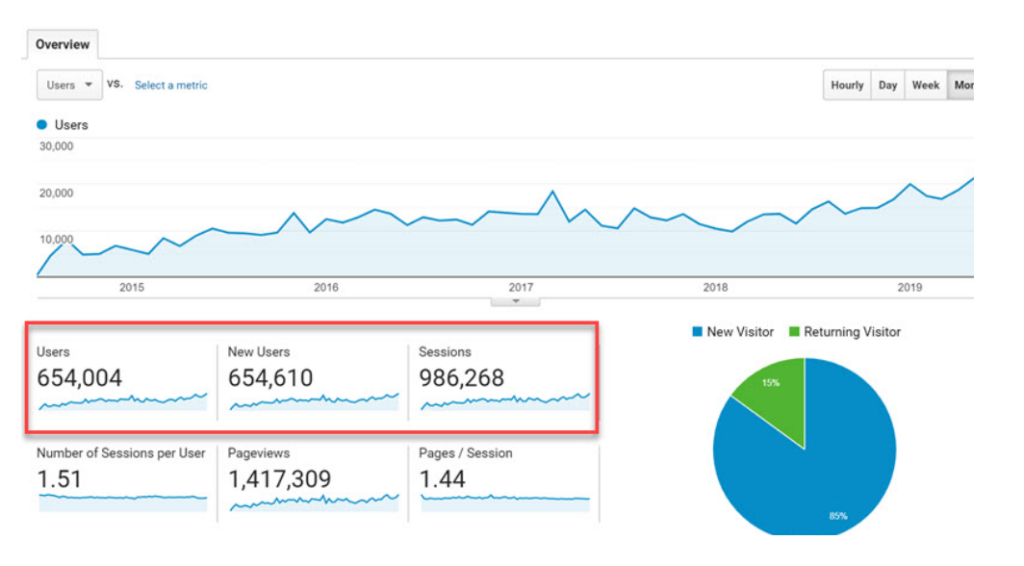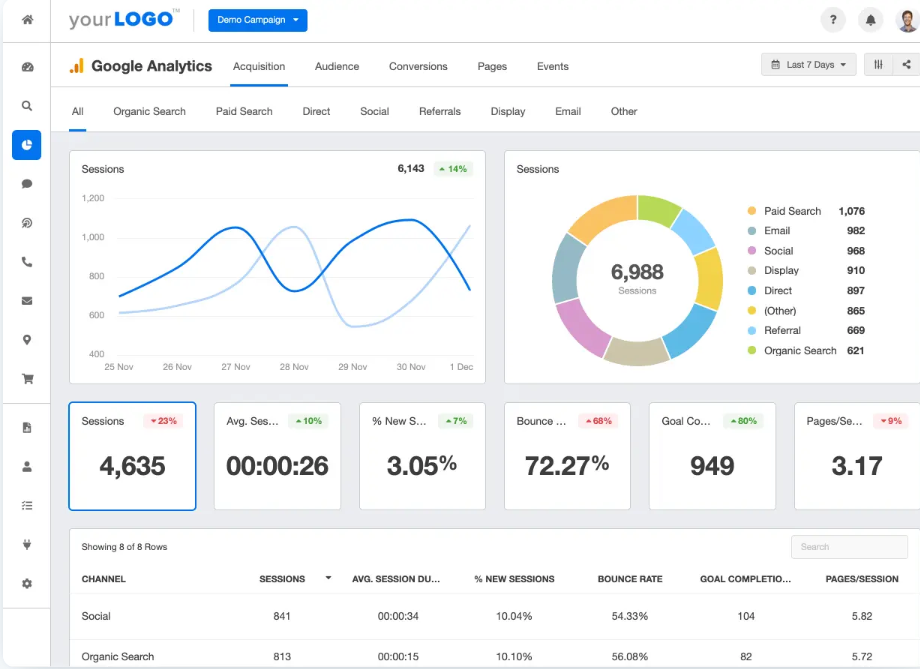Google Analytics website traffic is crucial to understanding how successful your SEO efforts are. In today’s online world, keeping track of your website’s visitors is crucial.
Whether you’re running a small shop online, managing a blog, or overseeing a company’s digital presence, knowing how to use Google Analytics can give you a big advantage.
This guide is all about making it simple for you to use Google Analytics to check on your website’s traffic and performance.
We’ll walk you through everything you need to know, from setting it up to reading the data it gives you. Let’s look at how Google Analytics can help you measure your SEO success the right way.
- What is Google Analytics Website Traffic?
- Setting Up Google Analytics for Your Website
- Navigating Through Google Analytics Dashboard
- The Key Metrics to Watch in Google Analytics Website Traffic
- Segmenting Your Google Analytics Website Traffic for Better Insights
- Analyzing Google Analytics Website Traffic Sources
- Using Google Analytics Reports to Improve SEO Strategy
- Tracking Conversions: The Ultimate Indicator of SEO Success
- Common Pitfalls to Avoid When Analyzing Google Analytics Website Traffic
- Maximizing Your SEO Success with Google Analytics Website Traffic Insights
- FAQs
- How often should I check my Google Analytics website traffic?
- Can Google Analytics help me improve my website’s SEO?
- What is the difference between ‘Pageviews’ and ‘Sessions’ in Google Analytics?
- Why is my bounce rate high, and how can I reduce it?
- How can I track the success of a specific marketing campaign in Google Analytics?
What is Google Analytics Website Traffic?

Website traffic refers to the number of visitors that land on your site. It’s a core indicator of your site’s health and performance. It affects everything from your site’s ranking on search engines to your bottom line.
Google Analytics, a robust analytics tool, plays a pivotal role in tracking this vital metric. It offers a window into your audience’s behavior and your website’s effectiveness in attracting visitors.
What is Google Analytics? It’s a free tool provided by Google that tracks and reports website traffic.
It gives you a detailed view of your audience, how they interact with your site, and what actions they take during their visit.
Understanding these metrics is key to refining your SEO strategy and enhancing your site’s visibility and engagement.
Setting Up Google Analytics for Your Website
Setting up Google Analytics is the first step towards unlocking the treasure trove of data it offers. Here’s a simple breakdown:
Create a Google Analytics account by visiting the Google Analytics website and following the sign-up process.
Add your website to your Google Analytics account by entering your website’s name, URL, and industry category.
Install the tracking code on your website. Google Analytics will provide you with a piece of JavaScript code to insert into your site’s header. This code is crucial for Google Analytics to start tracking your website’s traffic.
Proper setup is critical. Incorrect implementation can lead to inaccurate data, which can skew your analysis and lead to misguided SEO strategies.
Navigating Through Google Analytics Dashboard

The Google Analytics Dashboard is your control center. Here, you can view reports and metrics that offer insights into your website’s performance.
Familiarizing yourself with the dashboard is essential for efficiently monitoring your website traffic.
Real-time reports show you what’s happening on your site now.
Audience Reports provide demographic information about your visitors, such as age, gender, interests, and location.
Acquisition Reports help you understand how visitors find your site, highlighting the performance of different traffic sources.
Behavior Reports reveal what visitors do on your site, which pages they visit, and how long they stay.
Navigating through these sections will give you a comprehensive overview of your website’s traffic and user behavior.
The Key Metrics to Watch in Google Analytics Website Traffic
Understanding and monitoring key metrics in Google Analytics website traffic is crucial for any SEO professional. Here are some essential metrics you should keep an eye on:
Pageviews
The total number of pages viewed. Repeated views of a single page are also counted.
Sessions
A session is a group of user interactions with your website that take place within a given timeframe.
Users
Individuals who have initiated at least one session over a given period.
Bounce Rate
The percentage of visits in which a person leaves your website from the landing page without browsing any further.
Time on Site
The average amount of time users spend on your site during a session.
These metrics provide a snapshot of your website’s overall health and are indicators of your site’s engagement and attractiveness to your target audience.
Segmenting Your Google Analytics Website Traffic for Better Insights
Segmentation is a powerful feature in Google Analytics that allows you to dissect your website traffic to uncover more insights.
By segmenting your traffic, you can isolate and analyze subsets of your data for more targeted analysis. For instance, you can segment your audience by:
Geographic location
Understand which countries or cities are driving the most traffic.
Traffic source
Determine whether most of your visitors are coming from organic searches, direct visits, referrals, or social media.
Device
Find out how your audience accesses your site, whether through mobile, desktop, or tablet.
Segmentation helps tailor your SEO and content strategy better to meet the needs of your specific audience segments. This enhances user experience and potentially boosts your site’s SEO performance.
Analyzing Google Analytics Website Traffic Sources
Knowing where your website’s traffic originates is crucial for optimizing your marketing efforts. Google Analytics categorizes traffic sources into several main groups:
Direct
Visitors who arrive at your site by typing your URL into their browser or through bookmarks.
Organic Search
Visitors who come to your site from a search engine result.
Referral
Traffic that comes to your site from another site that links to yours.
Social
Visitors who come to your site from social media platforms.
By analyzing these sources, you can identify which marketing channels are most effective and allocate your resources accordingly. For example, if organic search is a significant traffic driver, you may decide to invest more in SEO.
If social media drives a lot of traffic, you might focus more on your social media marketing strategy.
Using Google Analytics Reports to Improve SEO Strategy
Google Analytics offers a variety of reports that can be instrumental in refining your SEO strategy:
Acquisition reports give you a clear view of how well different marketing channels are performing in terms of driving traffic to your site.
Behavior reports provide insights into what users do once they arrive on your site, which can help in optimizing the content and site structure for better engagement and conversion rates.
Conversion reports show how well your site fulfills your target objectives, be it e-commerce sales, newsletter signups, or other goals.
Regularly reviewing these reports can help you identify trends, pinpoint weaknesses in your SEO strategy, and adjust your tactics for better results.
Tracking Conversions: The Ultimate Indicator of SEO Success
Conversions is the lifeblood of any commercial website. They represent a visitor completing a desired action, such as making a purchase or signing up for a newsletter.
In Google Analytics, setting up goals allows you to track these critical actions and understand how well your site converts visitors into leads or customers.
To set up goals, you need to:
Define what constitutes a conversion for your site.
Set up the goals in Google Analytics by navigating to the Admin tab, clicking “Goals,” and then “New Goal.”
By tracking conversions, you can assess the ROI of your SEO efforts and focus on strategies that drive the most valuable traffic to your site.
Common Pitfalls to Avoid When Analyzing Google Analytics Website Traffic
While Google Analytics website traffic is an incredibly powerful tool, it’s essential to be aware of common pitfalls that can lead to misinterpretation of data:
Not setting up goals
Without goals, you can’t measure the effectiveness of your SEO strategy in achieving your business objectives.
Ignoring context
Seasonality, market trends, and external events can all impact your data. Always consider these factors when analyzing your metrics.
Focusing too much on vanity metrics
Metrics like pageviews or session length are important, but they don’t necessarily correlate with business success. Always relate your analytics to your specific business goals.
By avoiding these pitfalls, you can ensure that your analysis leads to actionable insights that genuinely improve your SEO strategy and website performance.
Maximizing Your SEO Success with Google Analytics Website Traffic Insights
Google Analytics website traffic can significantly boost your SEO efforts by providing deep insights into how visitors interact with your site.
This guide has taken you through the essentials, from getting started with Google Analytics to understanding the importance of tracking and analyzing your website traffic.
For those looking to get more from their SEO strategies, remember that expert help can make a big difference. Flying V Group is here to support you. We offer the expertise needed to harness the full power of Google Analytics for your business’s success.
Let’s navigate the digital landscape together, making your website not just visible but truly stand out.
FAQs
How often should I check my Google Analytics website traffic?
Ideally, you should review your Google Analytics weekly for a standard overview of your site’s performance. A daily check can provide immediate insights into visitor behavior and campaign effectiveness for websites with high traffic volumes or ongoing marketing campaigns.
Can Google Analytics help me improve my website’s SEO?
Absolutely. Google Analytics is a powerful tool that offers a wealth of data about your website’s traffic, user engagement, and conversion metrics. By analyzing this information, you can identify which aspects of your SEO strategy are working well and which areas need improvement.
What is the difference between ‘Pageviews’ and ‘Sessions’ in Google Analytics?
In Google Analytics, ‘Pageviews’ represents the total number of individual pages that have been viewed by your visitors, including repeated views of the same page. ‘Sessions’ refers to a group of interactions that take place on your website within a given timeframe, and it times out after 30 minutes of inactivity.
Why is my bounce rate high, and how can I reduce it?
A high bounce rate indicates that visitors are leaving your site quickly without engaging with more than one page. Maybe content that doesn’t meet the visitor’s expectations, poor website navigation, slow loading times, or unattractive web design. Ensure your content is relevant and engaging, improve site speed and user experience, and make navigation intuitive.
How can I track the success of a specific marketing campaign in Google Analytics?
Google Analytics allows you to use UTM (Urchin Tracking Module) parameters to tag URLs used in your campaigns. Adding these parameters to your campaign URLs can monitor how users from different sources interact with your site. It also enables you to make data-driven decisions, optimizing your marketing efforts for better results.






0 Comments